If you read through the previous blog post about THE crossing, you may get the idea that such a crossing isn’t really that much of a deal, that it’s easy and you’ll be on the other side before you know it. That is not quite the case. So, here’s some extra info about THE crossing with a little more excitement and thrills….
Yep, THE crossing. So much has already been said and spoken about it in advance: “That you are going to do that….”, “You are brave”, “You are crazy”, “I would like to do that too!”, “Hów long will it take??”, etc. Of course, we also dreaded this beforehand and we were able to postpone the thought for a long time with the idea that it would take a while before THE crossing would present itself and that we could always decide not to cross. But now the time had come: we were now in Cape Verde after all, so THE crossing was imminent, going back from Cape Verde is actually no longer an option (and at least as long/scary as THE crossing), and we now had done a number of shorter crossings, which made THE crossing seem a lot less scary than a few months ago.
In Mindelo, THE crossing was the talk of the town. Actually, the majority of the boats that are there around that period are there for THE crossing. All those boats are getting supplies and everyone is constantly checking the weather for a favorable weather window. The latter, of course, only makes sense to a limited extent. THE crossing normally takes about 2 to 3 weeks and a weather forecast for 2 to 3 weeks is not very reliable to say the least. But hey, it’s handy for the first few days. The first period we were in Mindelo there was little wind. Perhaps too little to make a departure meaningful, but luckily we didn’t want to leave then anyway. When we did get ready for a departure, the situation was reversed: there was too much wind: 25-30 knots (force 6 to 7) which in the acceleration zone in front of Mindelo (between São Vicente and Santo Antão) means that 10 knots can be added. Pfff….
The weather forecast showed that the wind should decrease somewhat during the week. The departure date therefore also moved a bit. However, a weather forecast is also open to interpretation. One neighbor was sitting on hot coals and thought that it was all okay and that we should not leave too late because there would be a windless period coming up. The other neighbor saw more “bears on the road” and thought it would be better to wait because next week there would be an area with high winds further down the route….
In the end, as said, we left on Friday December 3rd. The Janjorem also left that day, an hour before us, and other boats also decided it was a good time. Our Swedish neighbor decided to stay put until a (in his eyes) better weather window presented itself.
The wind was still quite strong, which meant that it was again a rough ride in the acceleration zone just before Mindelo. Only on the inner jib we bounced out. We saw other boats around us take off under almost full rigs but soon reefed back to a minimal amount of sail.
Once in the wind shadow of the opposite island of Santo Antão, the wind completely disappeared. Then night fell too. So, we had to look for the border where the optimal wind could be found, not too much wind next to the island, but also not too little wind behind the island. We even had to start the engine twice that night to get out of a calm area. In the end we sailed through the night on the genoa.
The waves are less changeable than the wind. Where the wind can just drop away, the waves just continue and that is really annoying: waves but no wind. Then you bounce and roll in all directions because the stabilizing effect of the wind in the sails is missing.
But this crossing we also move quite a bit with the sails up. After the first night we set the sails for the new (downwind) course: we put out poles on both the starboard and the port side, on which we can set the genoa on one side and the inner jib on the other. We don’t set the mainsail. This would turn out to be the sail setting for the next two weeks, we only vary the amount of sail by furling in the genoa and/or the inner jib more or less.
This sail setting is nice and easy, but also offers little of the aforementioned stability. Since the sails are transverse to the boat, the roll movements of the boat along the longitudinal axis are not counteracted by the sails. This means that the boat can move (roll) “freely” from side to side and it likes to do that, especially with big waves. And that means that we have actually been in a constant left-right movement throughout the crossing. So, you always have to hold on and brace yourself, everything takes effort to accomplish (especially toilet visits) and inside the boat everything slides, moves and rattles to keep you from sleeping.
The waves are quite big in the beginning because of the strong wind that has been enduring for days. And they are also quite messy: instead of neatly coming from one direction, the sea is often quite disturbed. This is also apparent when Ingo has to look for a friend again in the first two days, despite the plaster. His former blue friend had already been reserved for No, who is also not feeling well (but ultimately does not actually use her blue companion). Ingo soon found a new friend, black this time, and he and this bucket are inseparable for the first two days. He does, however, still take his shifts so once again: hats off!
After the first two days the wind and the sea do become a bit calmer, but it is still quite windy and messy. It only becomes a little more pleasant in the second week, but here too the sea does strange things. Once every hour (sometimes more often, sometimes less) the waves have playtime: they have the greatest fun coming from all sides and bumping into each other as high as possible, a bit like Neres and Antony do as one of them has scored. After a while it is over and the waves come to rest again and more from one direction. No idea where it comes from. It seemed as if there was a strange counter current to be found in the water.
After a few days a strange noise started developing from under the stern of the boat. The rudder seemed to vibrate in an odd way as the boat surfed down a wave and went a little faster. After hearing it for a while, I decided to investigate where it could come from. The rudder installation is located in our aft cabin, half under our bed. After removing some panelling, I quickly see what is wrong: the bolt of the turning block on which one of the steering cables runs to the rudder has loosened itself! With that, the turning block has come loose and it just hangs on a last piece of the bolt. The steering cable is also very slack. The rudder also tends to get stuck if the quadrant pinches against a steel retainer of the turning block. Before long, the cable would have run off the block and that would have rendered the ship out of steering control, and possibly the turning block itself would have jumped off to a place where you can’t find it or get it back again. So, it was discovered just in time!
After some fiddling in a hard-to-reach place with a moving rudder because of the auto-pilot, I finally manage to restore things. The turning block is back in place, the bolt retightened and the cable is working again. It even seems that the (windvane) steering is now doing a better job than before, possibly because of less play on the rudder control. Also, the noises have become a lot less. All in all, quite a relief.
However, when I do a check after a while to see if everything actually stays put again, I am really shocked. I hardly believe what I see: when the rudder turns, I see the rudder shaft not only turning but also moving sideways! In fact, I can see the entire bottom of the ship around the rudder flex! Every time we surf down a wave or do a steering movement I see the bottom deforming and flexing due to the lateral pressure of the rudder. Ouch!
There you are, 500 miles from Mindelo, 1500 miles to go to the other side. Going back is not an option, continuing means riding another 1500 miles of waves and making steering corrections. The worst scenarios run through my head: What if cracks appear? What if the bottom bursts? What if the rudder breaks out? What if ….?
After the first shock, I contact an expert in the Netherlands via email using our satellite phone, the person who also inspected our boat when we purchased it and who is therefore somewhat aware of the boat itself and its construction. After some e-mailing back and forth we come to the conclusion that it is probably not something that has just arisen but has been going on for some time. Perhaps even since the beginning and somewhat inherent in the construction of the boat. I only discovered it now because I’ve never had my nose on the rudder before driving off high ocean waves, you don’t do that very often…. It is something to keep an eye on to see if it does not deteriorate, so since then we’ve slowed down a bit (if you can control that) and I’ve checked the rudder and the bottom at least once a day. We also put the propeller so that it no longer turned freely because this seemed to cause turbulence on which the rudder vibrated (it does make a difference in speed by a few tenths, but a la….).
Fortunately, the situation seemed to remain stable and when the conditions became less rough, my worries subsided somewhat. In the end, we made it to the other side and I am now in Suriname looking at it and discussing what can and/or should be done with the limited resources that are available here.
Was it just stress and worries? No, of course not. It was also beautiful and exciting in a good way. The night shifts, the wide ocean, the birds, the dolphins, etc. The days are filled with routine such as getting the weather forecast with the satellite phone, determining and/or adjusting the course and possibly sail setting, keeping watch, eating, sleeping, etc., yet the days are never the same. We hardly saw any boats, but after a few days we did have one boat on a collision course at night. So you have such a vast ocean where you don’t see anything or anybody and then precisely that one boat that turns out to be in the vicinity is exactly on a collision course. And of course also when we had just decided that the VHF could actually stay off because we didn’t see or encounter anything anyway. When Ingo woke me up due to the impending collision, I quickly turned on the VHF radio and sure enough, the boat in question was calling us on the VHF. It turned out to be a (Chinese?) tuna fishing boat that was fishing and therefore had limited maneuverability. After discussing how we would pass each other, we wish each other a good sailing or catch and we pass each other less than half a mile away.
Did something else (almost) go wrong? Yes, during a check in the second week I discovered that one strand was broken on the port side lower stay, just above the crimped-on terminal. For the laymen: the stays are the steel wires that keep your mast upright and straight. A stay that breaks gives a reasonable chance that your mast will break and/or go overboard. Now a stay consists of 19 thinner steel wires so if one strand breaks there is not yet a man (or mast) overboard, but it is a sign that the stay is apparently getting tired and that next to that one strand more strands are likely to break. Something to keep an eye on and perhaps something to do something about. For this situation I had brought some extra material and with that fabricated an emergency stay that I placed next to the existing stay. For that I had to go up the mast, which is not really pleasant on a rolling boat. Fortunately, it was a lower stay so I only had to go to the spreaders (halfway up the mast). The emergency stay could support the existing stay and if the stay was to break, it could take over its function. With this we also made it across, although this repair has to last a little longer since we can’t repair this here in Suriname, but only in the Caribbean.
All in all, of course, we still had a pretty good crossing. And quite fast too: in 13.5 days from Mindelo to Iles du Salut, a distance of 1,845 miles in 326 hours. An average of almost 5.7 knots, so not bad. But you can perhaps imagine the relief at the first sight of land that everything and everyone has held up well until the end…..
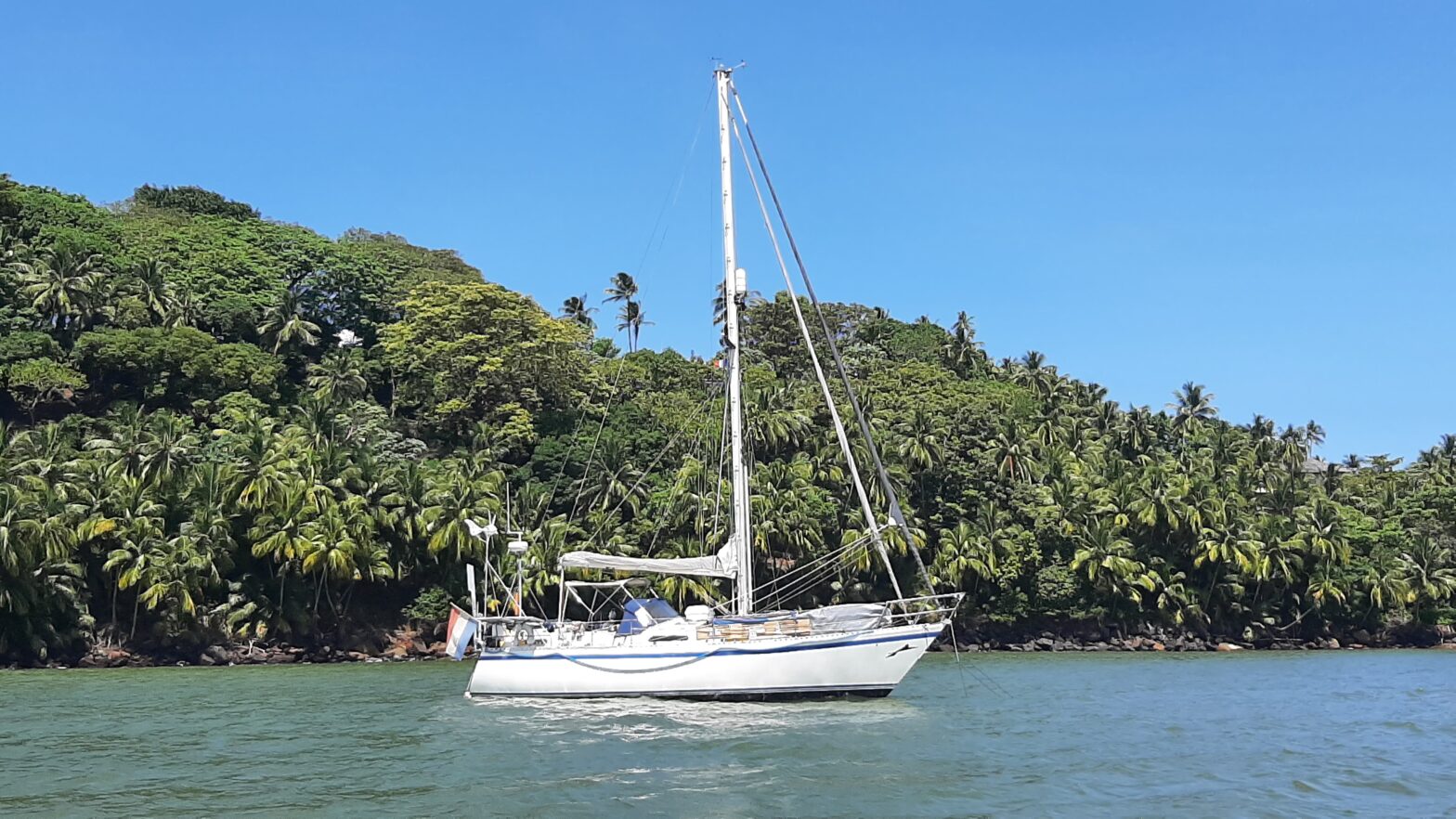
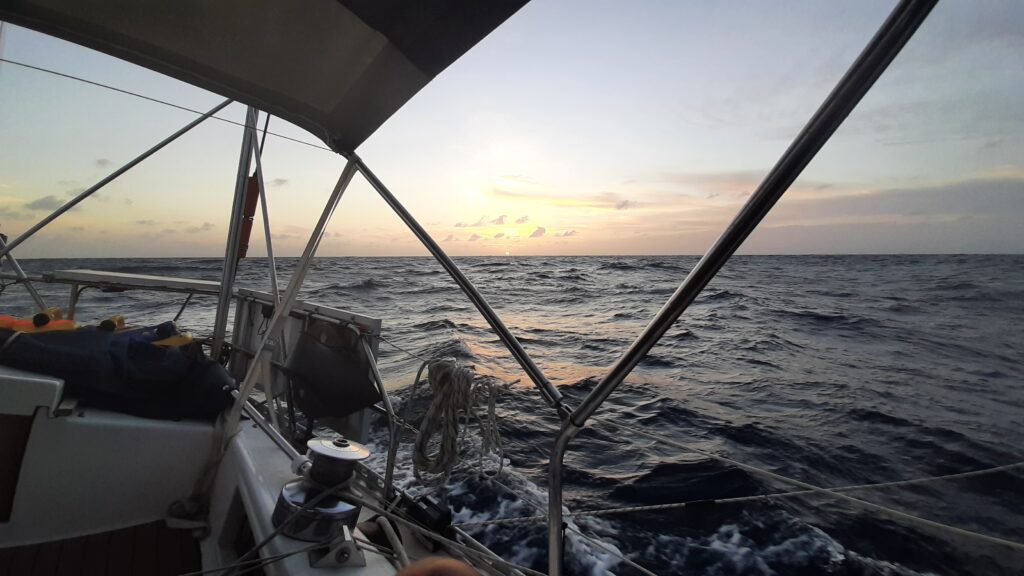
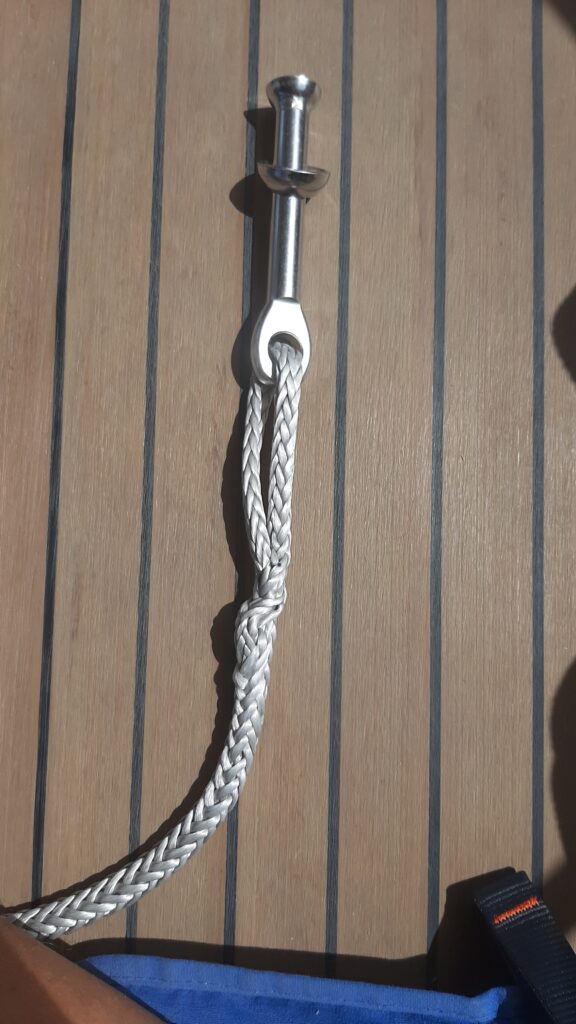
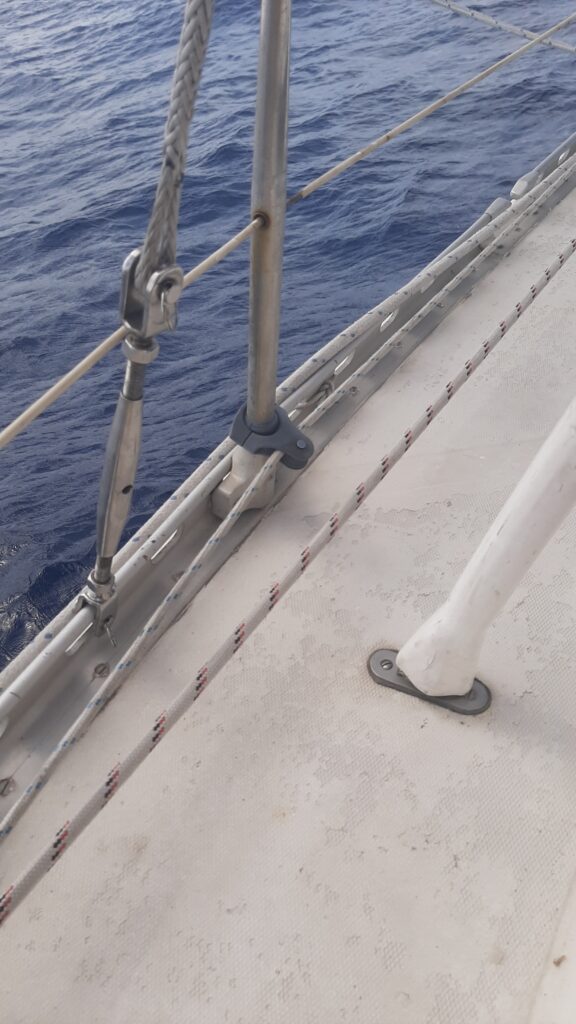
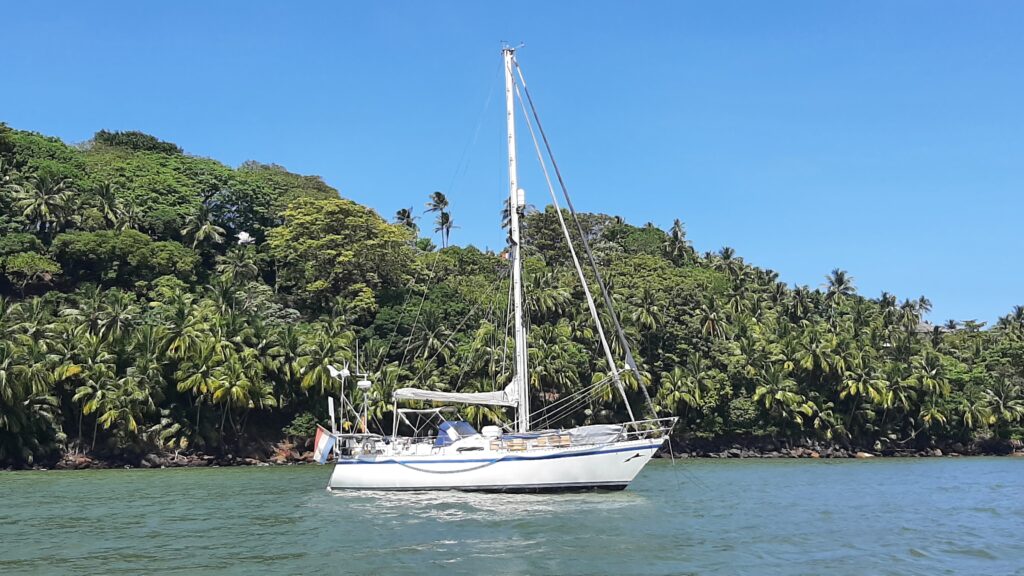
Happy Birthday, Nobilé!!
All the best for the new year to y’all, cheers!